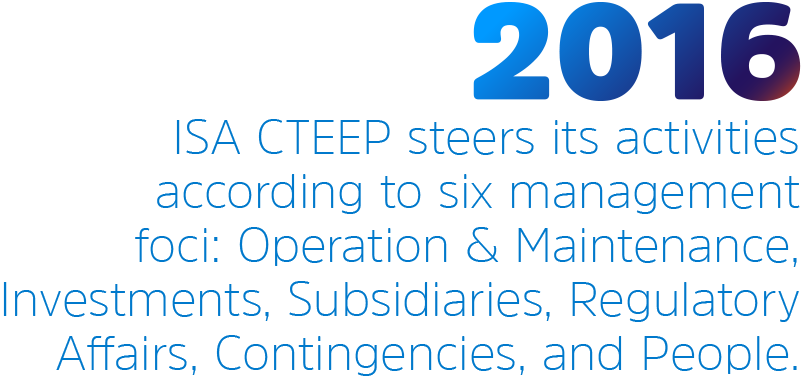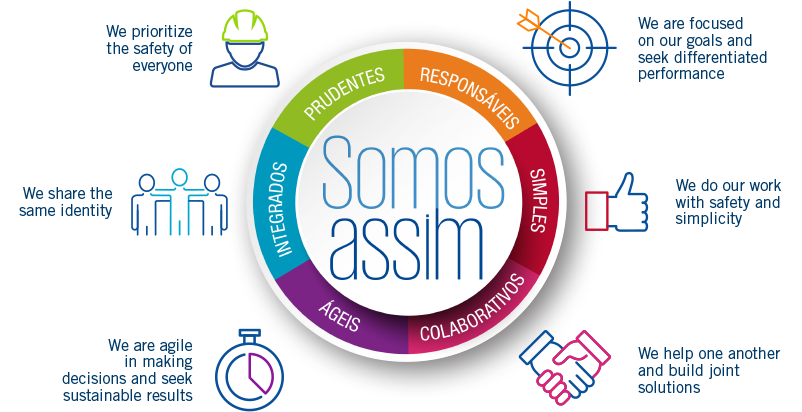G4-56
To consolidate its strategy of continuous and sustained growth, each year ISA CTEEP invests in constructing the Strategic Planning for the following year. This process, which is developed with the direct involvement of company leaders, was highlighted in 2016 by the broader spectrum of employees involved.
During the year, the Company updated some of the components of the Corporate Reference Framework, which gathers the guiding elements for managing the business. And, in order to strengthen everyone’s engagement with the strategy, meetings were held between company leaders (and others) and the employees responsible for facilitating and monitoring the results of performance indicators.
The interactions with these interlocutors were motivated by a survey applied to this group in 2015, which indicated the need for more subsidies for effective strategic action.
The first event with company leaders gathered more than 100 collaborators (including officers, managers and coordinators) for a training workshop about what ‘strategy’ is in the business context, how to implement it through instruments such as the Balanced Scorecard, and how to apply this work at ISA CTEEP and its subsidiaries. In addition to discussing the challenges of implementing the strategy, the goal was to demonstrate the importance of not only effective leadership in this process, but also investments and management tools that help the execution of strategy, risk management in identifying weaknesses, and suggestions for improvements. For the first time, the coordinators were involved in this expanded view of the importance of each employee to the effectiveness of this process.
The second meeting was attended by company officers and managers, who analyzed the results and advances achieved in 2016 in order to define the guidelines of Strategic Planning 2017, reinforcing the role of each one in the execution of the proposed objectives. Based on the analysis of each objective of the strategic map, the level of compliance and the respective points of improvement were identified, to be considered in the planning for the following year.

Management Focuses
ISA CTEEP bases its strategy on efficient performance, on the discipline of economic-financial management, and on a discerning look at return on investments. These aspects, coupled with the synergistic performance among the various units, allow us to deliver a reliable and high-quality service.
In line with its strategic objectives, the Company also guides its operations to six management areas (Operation & Maintenance, Investments, Subsidiaries, Regulatory Affairs, Contingencies, and People), with the identification of strategic directives for each theme and the development of initiatives capable of strengthening and contributing to the sustainable growth of the business.
To develop its Operation & Maintenance activities with efficiency, quality and safety – this is the central objective that guides the ISA CTEEP efforts in this area. Consistent with this position, organizational changes were promoted in 2016, culminating in the reorganization of the Technical Directorate, ensuring a more synergistic model of performance between the Company’s units and strengthening strategic points of the customer service network.
During the year, the Maintenance Planning Coordination, theretofore subordinated to the Maintenance Management Division, was transferred to the Projects Department, with new nomenclature (Planning Coordination), and the other coordination offices of this Division became directly subordinate to the Maintenance Department.The activities of the Facilities Integration Division were distributed among the Maintenance and Operation departments, with the creation of a Commissioning and Protection Coordination, subordinate to the Operation Analysis Division. G4-13
This new form of operating was decisive for the Company to reach – in yet another year – significant indicators of efficiency, even vis-à-vis the challenges to be faced in this area:
- Preserving its position as ANEEL Reference Company for operational efficiency and quality in delivery of the service.
- Maintenance management, with adaptation to ANEEL Normative Resolution 729/2016, which introduces new rules on the quality of the transmission service, with significant impacts on the activities of expansion, operation and maintenance.

Ensuring profitability and return on investments, with discipline in the allocation of resources and optimization of CAPEX. To assure compliance with this directive, one of the fronts adopted by the Company was to improve the reading and understanding of the financial return of the projects.
This positioning resulted in a more assertive administration, able to identify and pursue maximum return from the projects. Moreover, the Company claimed for better economic conditions offered by ANEEL in authorization processes, as well as more detailed analysis of structural solutions defined by the EPE in the planning for system expansion.
The Expansion Planning Committee was established, responsible for conducting a preliminary study of the project. This work is noteworthy because it includes the financial bias in the search for technical alternatives that make the project feasible, mitigating risks and capturing synergies.
As a result of adopting integrated planning, several advances were made, such as better control and overall knowledge of the projects; cost reduction; integration of the areas involved, from planning to project execution; internalization of essential activities; improvement in internal procedures; adoption of budgeting techniques for controlling internal costs; streamlining of the purchasing process, which was integrated into project control; and integrated planning of interventions (strengthening and improvement + maintenance plan).
In 2016, ISA CTEEP continued the process of integrating its wholly-owned subsidiaries and associated companies, by developing actions to improve the corporate governance model of these companies, increasingly aligning operational and management processes and technological systems.
This, which is a priority issue for the Company, advanced during the year with the unification and standardization of administrative and operational procedures, which allow us to improve and unify governance of the business. As a result, 100% of financial planning and themes related to the budget management of subsidiaries were unified with the areas of ISA CTEEP.
Another action adopted by the Company was the creation of periodic meetings attended by the managers of all subsidiaries, to encourage and promote the exchange of information and best practices, which contributed to the integration process at different levels.
Maintaining a proactive stance in the pursuit of satisfactory solutions for all involved, ISA CTEEP moved forward on two regulatory issues with significant impact on the future of the company, obtaining positive results regarding the definition of the form of payment of the cost of capital to be added to the Annual Allowable Revenue of each transmission concessionaire covered by Law 12.783/2013, in line with MME Ordinance 120/2016, and the approval of the general conditions for the incorporation of “Other Transmission Facilities” into the fixed assets of electricity distribution companies.
- RBSE PAYMENT - With the publication of Ordinance 120, issued by the Ministry of Mines and Energy (MME) in April 2016, rules were established for payment of assets existing on May 31, 2000 and not fully depreciated as of December 31, 2012 (RBSE - Basic Network of Existing Service and RPC - DIT of the Existing Service), and resulting from the extension of the concession process covered by Law No. 12.783/2013. Despite being less than the amount claimed by the Company in a report filed with ANEEL in August 2014, the proposed amount of R$ 3.9 billion, which is in base-date 2012, was approved, with a positive impact on the financial results of the year. ISA CTEEP will continue to act vis-à-vis the competent authorities to seek fair value for non-depreciated assets, with an estimated claimed value of R$ 400 million.
- DIT - Discussions on the transfer of the DITs, from the transmission companies to distribution companies, advanced with publication of ANEEL’s Normative Resolution 758/2017 and the definition that only the exclusive DITs not covered by MME Ordinance No. 120/2016 will be transferred (arising from extension of the concession process), excluding shared DITs, DITs used by power plants or “free” consumers, or those located in the Border Basic Network substations. Therefore, only four of the substations and slightly under 100 km of ISA CTEEP power lines will be impacted, also warranting a thorough analysis of these assets for compliance with the criteria set by the regulatory agency.
- REIDI - ISA CTEEP has encouraged the debate with the relevant agencies for the reformulation of the process of obtaining the Special Regime of Incentives for Infrastructure Development (“REIDI”), in order to ensure tax incentives for infrastructure projects, in a timely manner, considering that granting of the benefit is often delayed, affecting the purchase of equipment and fulfillment of construction timetables.
During the year, ISA CTEEP was also focused on reducing contingencies, maintaining proactive performance in the resolution of lawsuits and legal liabilities. As a result, the Company achieved new advances in relation to payment of the supplement to those benefited from Law No. 4.819/58.
The definition in 2015 by Brazil’s Supreme Court on the jurisdiction of the Courts of Justice, and not of the Labor Court, to judge the lawsuit that deals with these payments ensured significant advances throughout 2016, such as the debt collection lawsuit declaring the São Paulo State Treasury’s responsibility for the transfer of amounts spent theretofore by ISA CTEEP, and determines the repayment of amounts that had not been previously transferred by the State Treasury.
People
Aware of the importance of human capital to achieving and consolidating positive results for the business, in 2016 ISA CTEEP began a transformation project of the organizational culture that encourages an environment of new levels of behavior that abide by the culture necessary for the Company to be prepared for future challenges.
In line with this proposal, six traits were established that reflect the behaviors that employees must have in order to achieve the necessary culture that will help the company reach a new growth cycle, namely: prudent, responsible, simple, collaborative, agile, and integrated.

To promote this development in a structured and efficient way, the Culture Team was created, composed of employees from different departments, which meets periodically to monitor, discuss and propose initiatives to assist in the consolidation of the changes in the Organization. With sustainable and enduring insight, these collaborators analyzed and made reflections on the current culture, and the culture necessary for the next decades ISA CTEEP’s evolution.
Moreover, a number of actions to disseminate the new culture are being promoted, involving all professionals at different levels, with the active participation and commitment of the Company’s leaders.

Research & Development
G4-EU8
In an ever-changing world, innovation is present in all areas, driving business, creating opportunities, and seeking to improve the quality of life in an increasingly sustainable context. In this scenario, many challenges appear in the electricity sector, with the diversification of energy sources and the growing introduction of renewable sources in the conventional system, requiring an advance in management concepts and smarter techniques for the planning and expansion of power grids.
Aware of its role in the Brazilian electricity sector, ISA CTEEP has sought –through innovation – the differential required to boost operational efficiency and maintain reliability in providing services in a sustainable and socially responsible way. In a responsible and discerning manner, technological themes and routes are selected, that adhere to the pursuit of excellence in the provision of electricity transmission services for the population, with safety, reliability, modernity and innovation, which are the drivers of the Company’s research projects.
The Company believes that economic growth and social development are strongly influenced by knowledge, and therefore seeks to invest strategically in innovation, training, scientific research and new technologies, in search of technical excellence and performance with more quality and efficiency, in order for the company to develop on a solid and sustainable basis.
Accordingly, the Program for Technological Research and Development of the Electric Power Sector – R&D, regulated by ANEEL, is an important tool to enrich the innovative environment, promoting the generation and development of projects that are impactful for the sector, and contributing significantly to the management of business and sectoral knowledge.
Since the program’s inception (in 2001) until 2016, ISA CTEEP has earmarked a total of R$ 72 million for 105 projects involving more than 40 partnerships with institutions of higher education, public and private universities, companies, and renowned research centers, with strong involvement of its employees, seeking to encourage professional and academic training, thereby generating a steady stream of knowledge.
EVOLUTION IN R&D INVESTMENTS AT ISA CTEEP
| 2014 | 2015 | 2016 | |
|---|---|---|---|
| Total amount invested in R&D (R$) |
2,471,908.67
|
1,731,625.00
|
2,016,919.34
|
The results obtained in the projects developed by ISA CTEEP and its partners are reflected in the training courses completed and academic degrees earned, as well as academic publications and significant participation in technical events, academic events, and electric industry research groups. Specifically, in 2016, we invested R$ 2 million in projects already in progress, involving the following research efforts:
- Project SUPERCABO
-
- Developed by the Rural Federal University of Rio de Janeiro (UFRRJ), in a partnership with (proponent), ECATE, Novatrans Energia, and Transmissora Alianca. It seeks to develop a technology of high-temperature superconductor cable technology for electrical power systems. Amount contributed in 2016: R$ 2,500
- Project Solar (Photovoltaic Generation)
-
- Developed by the Institute of Energy and Environment of the University of Sao Paulo (USP), with the participation of CESP as a cooperator. It proposes the development of skills and evaluation of technical and commercial arrangements for distributed generation with photovoltaic systems connected to the network, seeking to identify the influence of intermittent generation on the transmission network as well as actions to ensure the controllability of the system. Amount contributed in 2016: R$ 19,000.
- Project WEATHER SENSOR
-
- It involves the development of an integrated sensor for measuring and transmitting real-time data of atmospheric discharges, temperature, wind and rain, with the development of a georeferenced platform for collection and transmission of these data, supporting the monitoring of the weather conditions and the issuance of alerts that assist in the maintenance of the transmission system. In 2016, the system was made fully available for testing, with stations installed at strategic points in São Paulo, in order to provide the best scenarios for meteorological forecasting and issuance of severe weather warnings. Amount contributed in 2016: R$ 155,000.
- ASSET MANAGEMENT Project
-
- Initiated in 2016, this project involves the development of a methodology capable of aiding in the identification of opportunities and strategies in the asset management process of an electrical company, functioning as an integrated tool to support decisions, through evaluation and diagnosis of the life cycle of the assets. By indicating the ideal time for asset replacement, frequency of inspections, testing and maintenance, the project contributes to reducing the failure rate in assets and the quality of service to society. Amount contributed in 2016: R$ 1.7 million.
During the year, we also strengthened the innovative actions developed in conjunction with ISA, notably the support for a study on Energy Storage, intensified by an agreement between the Group and the USTDA (US Trade and Development Agency) to study the feasibility and potential of the battery business in Latin America (Brazil, Colombia, and Mexico).
Additionally, in 2016 ISA CTEEP submitted a Strategic Project to ANEEL, developed in partnership with IEE/USP, CPq: D (Center for Research and Development in Telecommunications) and domestic manufacturers, with the aim to develop an energy storage system for the provision of services supplementary to the electric network, with intermittent generation arising from alternative sources, and to propose regulatory requirements for the integration of these systems to the power grid, offering the possibility of providing better quality of electricity and increase the reliability, safety and availability of this supply of electricity.


